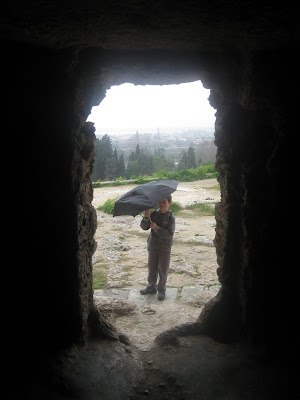We woke up to foggy skies and light rain this morning. The forecast said it would be a cloudy rainy day. Not a good day to ride the ferry to the Aeolian Islands.
We decided the head south, to Syracuse. Syracuse is located on the southeast corner of Sicily. This odd shaped city is divided between the mainland Syracuse and Ortygia island, the old part of the city which is connected to the mainland by a bridge. In it's day, Syracuse was a rival to Athens in power and prestige. It's history dates back 3,000 years.
Our first stop was the Neapolis Archaeological Park. This is Syracuse's most visited site. It boasts rock quarries, a Greek theater and Roman ruins.
The Puffle
Antiteatro Romano - Roman Amphiteater. This is a 2nd century AD Roman amphitheater, the third largest in Italy after the Colosseum in Rome and the Arena in Verona - Wow, we have now seen all three of these. This one was used for gladiator fights and horse races.
Ara di Lerone II - Alter of Hieron II. 3rd century BC monolithic sacrificial altar where 450 oxen could be killed at one time.
Teatro Greco, hewn outof the rocky hillside. This ancient theater could seat 16,000 spectators who saw the works of Sophocles, Euripides adn Aeschylus here.
Catacombs dug into the rock above the Teatro Greco.
Teatro Greco from the stage area.
Grotto dei Cordari - one of several man made caves down in the quarry. This one was supported by pillars and was used as a place to manufacture rope. Humidity is essential to rope making and the cave had plenty of it.
Sicily has lemons and oranges and all sorts of citrus
From the archeological park we walked a few blocks to the Museo Archeologico Paolo Orsi. This museum contains an extensive collection of prehistoric artifacts to early Greek settlements. We walked through two of the three exhibit halls before getting tired of looking at pottery, jewelry and other remnants.
Our next destination was the island of Ortygia, where the old city is located. It is a collection of Greek, Norman, Aragonese and Baroque cultures.
Crossing the Ponte Nuovo, past the inner harbor
We had lunch here at La Rambla, along the waterfront. This building was influenced by the Venetian period.
Tempio di Apollo, one of the first Greek structures built here. It is a 6th century BC Doric structure.
Old and new, sitting in a back lane we wandered through
The source of our euros, a Postamat, run by the Italian Postal Service
Piazza Del Duomo. Syracuse's Greek history is disguised into the baroque veneer of the Duomo. You can see the Doric columns of the Greek Temple of Athena in the walls.
Interior shots of the Duomo. The original Greek temple was renowned throughout the Mediterranean, thanks to Cicero who visited Orygia in the 1st century BC.
Statue in Palazzo Municipale.
While sitting on the steps of the Duomo, I was visited by this cat who wanted a friend.
Another view of the Duomo
We found this Pringles vending machine on one of the streets we walked down. I've never seen a machine for Pringles!
When we arrived back in Taormina we stopped at our new favorite bar, Carpe Diem, for a light dinner. Salvatore was there and was sang some classic Italian songs for us again while we enjoyed some wine and more bruschetta.
It was another fine day in Sicily, even if the weather was a bit cloudy and chilly. We will wait until tomorrow to decide what we will do on our last day in Sicily. So far, it looks for be a rainy one.




























No comments:
Post a Comment